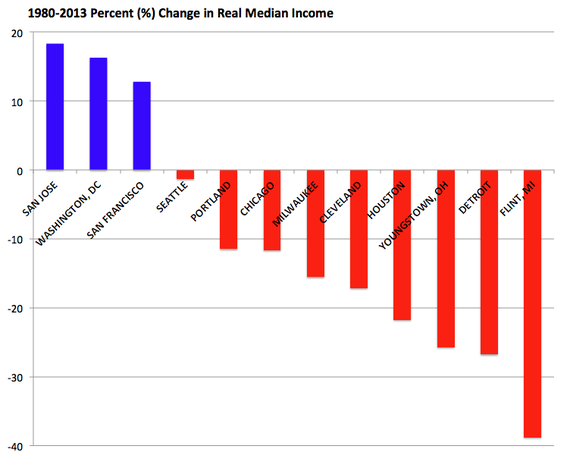The Richest Cities for Young People: 1980 vs. Today

In 1980, Flint, Michigan, had the highest median income for young workers in the country. It has since lost more than a third of its population. Carlos Osorio/AP
Five of the ten richest cities for young Boomers have since seen median wages for young people fall by at least 15 percent.
Today, there are lots of articles telling young people which cities have the most college gradates , the highest wages , and the most jobs . These are perfectly useful guides to the near future. But it's interesting to look back at the best cities for young workers in 1980 to see how often history intervenes with extrapolated trends.
The graph below considers the ten large U.S. cities (with population greater than 450,000) with the highest median incomes for young workers in 1980, according to Census figures. Flint and Detroit finish one and two. If you click on the 2013 number at the top, you can see how those cities fared over the next 33 years.
For an at-a-glance look at this same dataset, here's one graph showing the 33-year change in median income by city.
In 1980, Flint's Median Income Was Higher Than San Francisco's. Then This Happened.

The cities in red suffer from various afflictions. For Flint, Detroit, Youngstown, Cleveland, and Milwaukee, the demise of manufacturing, steel production, and other off-shored blue-collar work have gutted these foundries of good middle-class jobs. It's also conceivable that Houston, which has recently added jobs faster than any other large city, has incorporated so many immigrants and lower-skill workers from other states in the last few decades that the sheer weight of its low-wage work has pulled down the median age for young people.
One theory for why rich cities tend to get richer is "cumulative advantage," which is more commonly known as the rich-get-richer principle. The idea is that cities with thriving industries (consulting in Boston; software in San Jose; commodities in Chicago) attract the smartest workers, whose talents add to the success of those industries, redoubling their ability to attract the smartest workers. Talent attracts talent. Business attracts business. A growing tax base supports better schools, nicer parks, and safer neighborhoods. Economic growth thrives on a feedback loop that, from a certain angle, appears to be infinite and unbreakable. In short: The rich get richer, forever.
And sometimes they do. It is hard to imagine a future for the Bay Area or New York City that looks like Flint, Michigan. The catch, however, is that 35 years ago, the city with the highest median wage for workers under 35 was, in fact, Flint, Michigan .
Today, the ten cities in the country with the highest median income for young people are, in order: San Jose, San Francisco, Washington, D.C., Boston, New York, Baltimore, Seattle, Minneapolis, Philadelphia, and Chicago. I think if you asked somebody to forecast what this list would look like in 20 years, he would offer something very much like this list. Why? Cumulative advantage, basically. The theory would be that the agglomeration of talent on the coasts will continue to attract the smartest cookies from college, further sorting the country into a handful of elite cities on the oceans, separated by a smattering of thriving metros and a vast hinterland.
But, as the Class of 1980 reminds us, history has a way of intervening with such crudely extrapolated trends. Five of the ten richest cities from 33 years ago have seen median wages for young people fall by at least 15 percent. The turnover rate of the list is 50 percent. So, yes, cumulative advantage is strong, and rich cities often get richer. But technology, globalization , and the availability of affordable housing and transportation all exert their own gravity. Extrapolating the present forward isn't the same thing as knowing the future.
NEXT STORY: The Miracle of Minneapolis





